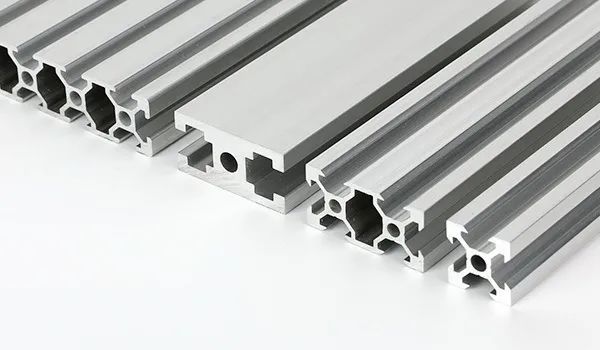Aluminum Classification
1. Aluminum Products Classification:
Rolled Material, Cast Material, Non-heat Treatment Alloy, Pure Aluminum Alloy, Aluminum Copper Alloy, Aluminum Manganese Alloy, Aluminum Silicon Alloy, Aluminum Magnesium Alloy, Aluminum Magnesium Alloy, Aluminum Zinc Magnesium Alloy, Aluminum and Other Element Alloy.
2. aluminum processing technology classification: casting material, heat treatment type alloy, non heat treatment type alloy.
3. aluminum processing products classification:
rolling products: sheet (Sheet), plate (Plate), roll sheet (Coil), strip.
Extrusions: tubes, solid bars, profiles (Profiles).
Casting products: Castings.
| Aluminum use
1. Aluminum profiles for construction: mainly including aluminum profiles for doors and windows and aluminum profiles for curtain walls.
2, radiator aluminum profile: mainly used in all kinds of power electronic equipment heat dissipation, LED lighting heat dissipation, and computer digital products heat dissipation.
3, industrial aluminum profile: mainly used for industrial production and manufacturing, such as automatic mechanical equipment, the skeleton of the enclosure and the customized mold opening of each company according to its own mechanical equipment requirements, such as assembly line conveyor belt, elevator, glue dispenser, testing equipment, shelves, etc., electronic machinery industry and clean room, etc.
4. Aluminum profiles for auto parts: mainly used for auto parts, connectors, etc.
5, furniture aluminum profile: mainly used for furniture decorative frame, table and chair supports, etc.
6, solar photovoltaic profile: including solar aluminum profile frame, solar photovoltaic bracket, solar photovoltaic tile fastener, etc.
7, rail vehicle structure aluminum alloy profile: mainly used for rail vehicle body manufacturing. Aluminum alloy profiles have the characteristics of light weight, good formability, high strength, corrosion resistance and recyclability, and are more and more widely used in the field of rail vehicles.
8, mounted aluminum profile: made into aluminum alloy picture frame, mounted various exhibitions, decorative paintings.
9, medical equipment aluminum profile: stretcher frame, medical equipment, medical bed, etc.
| Aluminum profile model series
contains more than 99.00% aluminum, has good electrical conductivity, good corrosion resistance, good welding performance, low strength, and cannot be strengthened by heat treatment. Applications: Mainly used for scientific experiments, chemical industry and special purposes.
aluminum alloy with copper as the main compound element. Manganese, magnesium, lead and bismuth are also added for machinability. Disadvantages: serious tendency of intergranular corrosion. Applications: Aviation industry (2014 alloys), screws (2011 alloys) and industries with higher operating temperatures (2017 alloys).
3 series: 3000 series
uses manganese as the main alloying element, with good corrosion resistance and good welding performance. Disadvantages: low strength, but can be strengthened by cold work hardening. Coarse grains are easily produced during annealing. Scope of application: Seamless oil pipe (3003 alloy) and pop can (3004 alloy) used on aircraft.
is mainly made of silicon, with high wear resistance, low thermal expansion coefficient, easy casting, and low or high silicon content will affect performance. Application range: It is widely used in the piston and cylinder of motor vehicles, and is widely used abroad.
is mainly magnesium. Good resistance, good welding performance, good fatigue strength, not heat treatment to strengthen, only cold processing to improve strength. Applications: lawn mower handles, aircraft fuel tank conduits, bulletproof vests.
is based on magnesium and silicon. Medium strength, good corrosion resistance, good welding performance, good process performance, good oxidation coloring performance. Application range: currently the most widely used alloy, transportation (such as: car luggage rack, door, window, body, heat sink, box shell).
is mainly zinc, but sometimes a small amount of magnesium and copper are added. 7005 and 7075 are the highest grade in the 7 series and can be strengthened by heat treatment. Applications: Aviation (aircraft load-bearing components, landing gear), rockets, propellers, aerospace vehicles.
8 series: 8000 series , aluminum alloy is more commonly used for 8011 belongs to other series, most of the application is aluminum foil, aluminum rod production is not commonly used.
9 series
:9000 series , aluminum alloy is a spare alloy.
| aluminum profile purchase
hardness first with the chemical composition of the alloy has a direct relationship. Second, different states also have a greater impact. 7 series, 2 series, 4 series, 5 series, 3 series, 1 series, in turn decreased.
pure aluminum has the lowest strength, while 2 series and 7 series heat-treated alloys have the highest strength. Hardness and strength have a certain positive relationship.
Generally speaking, 1 series pure aluminum has the best corrosion resistance, 5 series performs well, followed by 6 series, 2 series and 7 series. The principle of corrosion resistance selection should be based on its use. The use of high-strength alloys in corrosive environments requires the use of a variety of corrosion-resistant composite materials.
4. processing performance
processing performance includes forming performance and cutting performance. Because the formability is related to the state, after selecting the aluminum alloy grade, the strength range of various states should be considered. Generally, the material with high strength is not easy to form.
If you want to bend, stretch, deep drawing and other forming processes for aluminum, the formability of the material in the fully annealed state is the best, and vice versa, the formability of the material in the heat treatment state is the worst. The cutting performance of
aluminum alloy has a great relationship with the alloy composition. Generally, the cutting performance of aluminum alloy with higher strength is better, on the contrary, the cutting performance of low strength is poor. For products that require cutting, such as molds and parts, the machinability of aluminum alloys is an important consideration.
Most aluminum alloys have no problems in welding, especially some 5 series aluminum alloys, which are specially designed for welding considerations. Part of the 2 series and 7 series aluminum alloy is difficult to weld.





